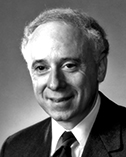
Joseph L. Goldstein
The University of Texas Southwestern Medical Center
|
Primary Section: 41, Medical Genetics, Hematology, and Oncology Secondary Section: 42, Medical Physiology and Metabolism Membership Type:
Member
(elected 1980)
|
Biosketch
Joseph L. Goldstein is Chair and Regental Professor of Department of Molecular Genetics at the University of Texas Southwestern Medical Center at Dallas. He and his colleague, Michael S. Brown, discovered the low density lipoprotein (LDL) receptor and worked out how these receptors control cholesterol homeostasis. At the basic level, this work opened the field of receptor-mediated endocytosis, and at the clinical level it lay the conceptual groundwork for development of the statin drugs that lower blood LDL-cholesterol and prevent heart attacks. Drs. Goldstein and Brown shared many awards for this work, including Lasker Award in Basic Medical Research (1985), Nobel Prize in Physiology or Medicine (1985), and National Medal of Science (1988). In more recent work, Drs. Goldstein and Brown discovered the SREBP family of transcription factors and showed how these membrane-bound molecules control synthesis of cholesterol and fatty acids through regulated intramembrane proteolysis. For this work, Drs. Brown and Goldstein received the Albany Medical Center Prize in Biomedical Research (2003) and Rolf Luft Award from Karolinska Institute (2016). Dr. Goldstein is currently Chair of the Lasker Awards Jury and is a member of the Boards of Trustees of Howard Hughes Medical Institute and Rockefeller University (Life Trustee). He is also on the Board of Directors of Regeneron Pharmaceuticals and serves as Chair of the Board of Scientific Counselors of the Broad Institute. He is a member of the National Academy of Sciences, National Academy of Medicine, American Philosophical Society, and the Royal Society (Foreign Member).
Research Interests
Current research is focused on the following areas: 1) Structure and function of the Scap/SREBP pathway for controlling lipid homeostasis 2) Biochemical pathway in steps by which LDL-derived cholesterol is transported from the lysosome to plasma membrane to endoplasmic reticulum where it carries out its metabolic functions. 3) Elucidating the physiological mechanism by which the blood glucose level is maintained by the Ghrelin-Growth Hormone axis during severe calorie restriction and starvation.

